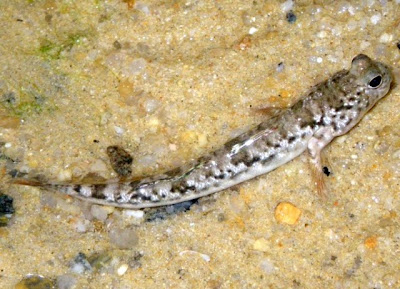East Coast Park is well known for its reclaimed sandy shores and previously there were visits to this shore during low tide to look at marine life among the sand.
Not only does East Coast have sandy shore that is alive, the rocks near or on the seawall are also full of life. Just like this Sally-lightfoot crab (Grapsus albolineatus) that was found today in the seawall crevice.

Another good habitat for life that usually is hidden from our sight will be the underneath side of rocks. The underside of rocks are usually much more exciting and colourful than the side that is exposed to the environment. One of the many animals that can be found here includes these two lain crabs (Family Porcellanidae).
Continuing the crab finds in different habitats, this Horn-eyed ghost crab (Ocypode cerathophthalmus) is usually found among sand. They usually only come out at night to hunt for food. During the day, they retreat back into their burrows which are sometimes evident in mid to high shore zonations.
Is there more to rocks and sand? Yes, it is the walls of structures that extend out into the sea. These walls are flat and huge. Lifeless it might seem from far, they are alive and filled with marine critters during low tide, like this Purple climber crab (Metopograpsus sp.) and Nerite (Family Neritidae).

More snails on walls include (from top left in a clockwise direction) a yellow drill which was also previously sighted, unknown snail, Spiral melongena (Pugilina cochlidium) as well as another species of nerite.
The walls seem to be crowded with different kinds of animals like the Drills (Family Muricidae) as shown above. There are also lots of oysters that jam up the surfaces of the wall.
And when its time to reproduce and proliferate, the wall is also home for tons of colourful egg cases of the drills to be attached onto.

James found this weird snail on the wall. After putting into a pool of water on the sandy to relax, the snail’s mantle came out. On the right is its underside. Is this a bubble snail (Family Haminoeidae) of some sort?
Snails need not to be always covered or armoured with a shell, just like the onch slugs (Family Onchididae). They are also very common on the wall structures!

Once in a while, one will happen to notice blob-like structures like this banded bead anemone. In fact, they are very abundant on the wall, just that they are too small for notice and we are usually distract by larger or cuter animals.
Another blob that grows out from hard structures will be the Thumbs-up sea squirt (Polycarpa sp.)
James loves worms on the walls and he has taken lots of photos on the different types of worms that crawl on the wall. As for me, I like this long Ribbon worm (Phylum Nemertea) that looks like a meandering river from an bird’s eye view.
I later found yet another worm- a flatworm. This beige coloured flatworm looks like phlegm for those who are imaginative. Haha.
There are many empty shells growing out from the huge wall but this one is just too intriguing. Ria showed me this fish that is trapped in between the dead bivalve shell. Or is it just living in it? The fish was still moving and alive when we saw this.
Yet another fascinating fishy find must be these orange blobs attached onto the shell on the wall. Comparing my finger to these blobs, you can imagine how tiny they are!
And what do you think they are? These are the eggs of probably a fish! James told me that I can see their two eyes if I take a close-up photo. Indeed, each blob has two eyes. Wow!
How about the bigger fishes? Yes, there are bigger fishes though they are of course not found hanging on the vertical wall. Haha. This Gold-spotted mudskipper (Periophthalmodon chrysospilos) was found on the rock near the seawall.
As well as this Dusky-gilled mudskipper (Periophthalmus novemradiatus) on the sand.

More critters on the vertical wall includes larger than normal Sea slaters (Ligia sp.) and Shore crickets.

Tiny and easily-overlooked crabs and a Green mussel (Perna viridis).

Last but not least, a Marine spider (Desis martensi) and an unidentified moth that are common on the wall and the coasts.
Tomorrow another trip back to East Coast Park!
Wednesday, August 19, 2009
Living walls of East Coast
Subscribe to:
Post Comments (Atom)


















No comments:
Post a Comment